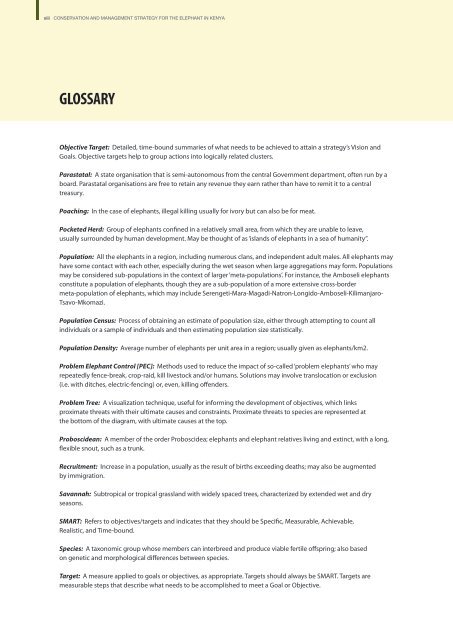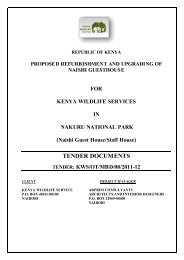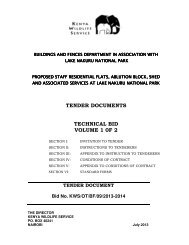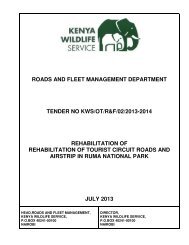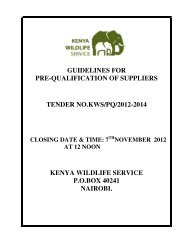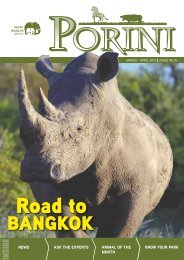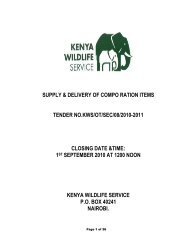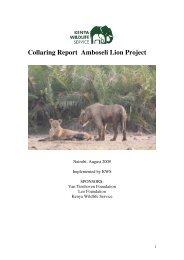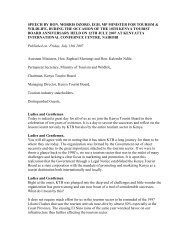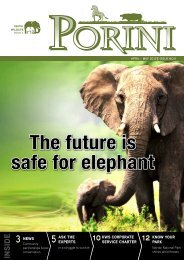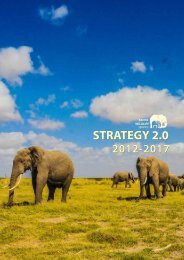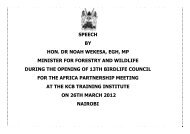Conservation and Management Strategy for the Elephant in Kenya
Conservation and Management Strategy for the Elephant in Kenya
Conservation and Management Strategy for the Elephant in Kenya
Create successful ePaper yourself
Turn your PDF publications into a flip-book with our unique Google optimized e-Paper software.
xiii CONSERVATION AND MANAGEMENT STRATEGY FOR THE ELEPHANT IN KENYA<br />
GLOSSARY<br />
Objective Target: Detailed, time-bound summaries of what needs to be achieved to atta<strong>in</strong> a strategy’s Vision <strong>and</strong><br />
Goals. Objective targets help to group actions <strong>in</strong>to logically related clusters.<br />
Parastatal: A state organisation that is semi-autonomous from <strong>the</strong> central Government department, often run by a<br />
board. Parastatal organisations are free to reta<strong>in</strong> any revenue <strong>the</strong>y earn ra<strong>the</strong>r than have to remit it to a central<br />
treasury.<br />
Poach<strong>in</strong>g: In <strong>the</strong> case of elephants, illegal kill<strong>in</strong>g usually <strong>for</strong> ivory but can also be <strong>for</strong> meat.<br />
Pocketed Herd: Group of elephants conf<strong>in</strong>ed <strong>in</strong> a relatively small area, from which <strong>the</strong>y are unable to leave,<br />
usually surrounded by human development. May be thought of as ‘isl<strong>and</strong>s of elephants <strong>in</strong> a sea of humanity’’.<br />
Population: All <strong>the</strong> elephants <strong>in</strong> a region, <strong>in</strong>clud<strong>in</strong>g numerous clans, <strong>and</strong> <strong>in</strong>dependent adult males. All elephants may<br />
have some contact with each o<strong>the</strong>r, especially dur<strong>in</strong>g <strong>the</strong> wet season when large aggregations may <strong>for</strong>m. Populations<br />
may be considered sub-populations <strong>in</strong> <strong>the</strong> context of larger ‘meta-populations’. For <strong>in</strong>stance, <strong>the</strong> Amboseli elephants<br />
constitute a population of elephants, though <strong>the</strong>y are a sub-population of a more extensive cross-border<br />
meta-population of elephants, which may <strong>in</strong>clude Serengeti-Mara-Magadi-Natron-Longido-Amboseli-Kilimanjaro-<br />
Tsavo-Mkomazi.<br />
Population Census: Process of obta<strong>in</strong><strong>in</strong>g an estimate of population size, ei<strong>the</strong>r through attempt<strong>in</strong>g to count all<br />
<strong>in</strong>dividuals or a sample of <strong>in</strong>dividuals <strong>and</strong> <strong>the</strong>n estimat<strong>in</strong>g population size statistically.<br />
Population Density: Average number of elephants per unit area <strong>in</strong> a region; usually given as elephants/km2.<br />
Problem <strong>Elephant</strong> Control [PEC]: Methods used to reduce <strong>the</strong> impact of so-called ‘problem elephants’ who may<br />
repeatedly fence-break, crop-raid, kill livestock <strong>and</strong>/or humans. Solutions may <strong>in</strong>volve translocation or exclusion<br />
(i.e. with ditches, electric-fenc<strong>in</strong>g) or, even, kill<strong>in</strong>g offenders.<br />
Problem Tree: A visualization technique, useful <strong>for</strong> <strong>in</strong><strong>for</strong>m<strong>in</strong>g <strong>the</strong> development of objectives, which l<strong>in</strong>ks<br />
proximate threats with <strong>the</strong>ir ultimate causes <strong>and</strong> constra<strong>in</strong>ts. Proximate threats to species are represented at<br />
<strong>the</strong> bottom of <strong>the</strong> diagram, with ultimate causes at <strong>the</strong> top.<br />
Proboscidean: A member of <strong>the</strong> order Proboscidea; elephants <strong>and</strong> elephant relatives liv<strong>in</strong>g <strong>and</strong> ext<strong>in</strong>ct, with a long,<br />
flexible snout, such as a trunk.<br />
Recruitment: Increase <strong>in</strong> a population, usually as <strong>the</strong> result of births exceed<strong>in</strong>g deaths; may also be augmented<br />
by immigration.<br />
Savannah: Subtropical or tropical grassl<strong>and</strong> with widely spaced trees, characterized by extended wet <strong>and</strong> dry<br />
seasons.<br />
SMART: Refers to objectives/targets <strong>and</strong> <strong>in</strong>dicates that <strong>the</strong>y should be Specific, Measurable, Achievable,<br />
Realistic, <strong>and</strong> Time-bound.<br />
Species: A taxonomic group whose members can <strong>in</strong>terbreed <strong>and</strong> produce viable fertile offspr<strong>in</strong>g; also based<br />
on genetic <strong>and</strong> morphological differences between species.<br />
Target: A measure applied to goals or objectives, as appropriate. Targets should always be SMART. Targets are<br />
measurable steps that describe what needs to be accomplished to meet a Goal or Objective.


